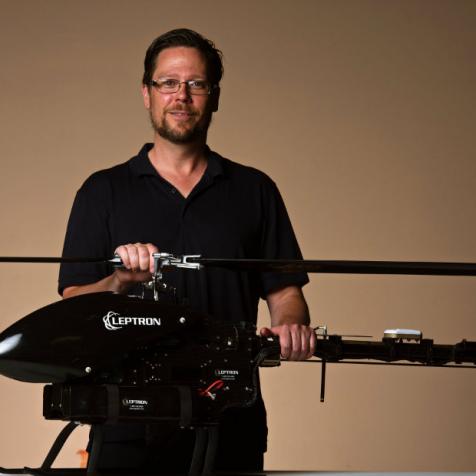
Leptron
By Eric Peterson | Aug 21, 2017
Company Details
Location
Denver, Colorado
Founded
2009
Ownership Type
Private
Employees
4 (Geotech: 122)
Products
Unmanned aerial systems
Denver
Founded: 2009 (acquired by Geotech Environmental Equipment in 2015)
Privately owned (a division of Geotech)
Employees: 4 (Geotech: 122)
Industry: Electronics & Aerospace
Products: Unmanned aerial services
CEO Jeff Popiel envisions a high-flying future for his company's unmanned aerial systems.
Founded in Utah before moving to Colorado, Leptron was "one of the first UAV [unmanned aerial vehicle] companies," says Popiel, who says he acquired the business because it complemented Geotech's focus on environmental monitoring equipment. The original target markets -- search and rescue, police and fire departments and military -- are now paired with companies that own mining and brownfield sites.

"The Army is one of our biggest customers," says Popiel of Leptron unmanned aerial systems (UAS). "We're flying for Geotech's customers around mines and landfills and other industrial sites."
For example, the Bureau of Reclamation uses Leptron drones to inspect the Elephant Butte Dam in New Mexico. "If you're at an active mine or industrial site, [inspection and mapping] is a dangerous job," says Popiel. The systems are also ideal for tracking change in a given area. "We can fly it in the exact same pattern and process the data in the exact same way."

Ranging from about $13,000 to more than $60,000, Leptron's catalog includes helicopters, quadcopters, and fixed-wing aircraft. The fixed-wing units can fly longer (an hour versus 30 minutes), but need 30 to 50 feet of runway to land. The UAS controller features a daylight-viewable, HD display. "It's easy to use," says Mickele Bragg, product manager for Leptron and Geotech.
The quadcopter can handle a 1.5-pound payload, while the helicopters are built to order with capacities of 15 pounds. Both copters can hover, allowing uses to zoom in on specific areas. "It's really application-specific," says Popiel. "Many of our clients are looking at multiple platforms."
Infrared capability allows the UAS to track missing people for search and rescue, and assorted hot spots in other applications. "You can look for people but you can also look for animals," says Popiel, noting that Leptron clients include state and federal agencies as well as ranchers.

Leptron also offers contract services (fees typically range from $10 to $18 an acre) and monthly weeklong certification classes for UAS operators. Bragg notes that students have a 100 percent pass rate after taking the $2,500 class.
But Leptron's services offer a turnkey process for leveraging the power of UAS; many customers would otherwise need a full-time staffer to understand and utilize the data. "It's not really about the platform, it's about the data," says Bragg. "That data is a really critical component of the business model, and it's trickier than flying a UAS."
Geotech manufactured parts for Leptron before the 2015 acquisition, utilizing 3D printing, machining, and composites in the units. Most components besides the electronics are made in-house. The Army wanted ISO 9000 certification, so Geotech obliged.

Leptron saw huge gains in its first year in Geotech's portfolio. Popiel says sales increased about 500 percent in 2016.
Challenges: "We're doing a lot of services work because people are unsure the business model will work for them in terms of owning their own aircraft," says Popiel. "We're flying jobs all over" -- as far away as Puerto Rico.
Market education takes time. "We're presenting information in a different way," he adds. "Everybody wants to buy a drone. Why wouldn't you? It's cool to fly a drone. But it still has to make business sense."
Opportunities: "Mapping and volumetric calculations," says Popiel, identifying a target market that's "lower and slower" than traditional aircraft. "That's the model. Can we do it at a lower cost and get better data than a manned aircraft or people walking around on the ground?"
He sees it as a great complementary business for Geotech's suite of environmental monitoring products, he adds. "It's been opening doors for us for sure. Every one of our engineering firms had been contemplating an UAV program."

Needs: Cash flow. Contracted UAS services "are expensive," says Popiel. He wants to grow the sales side to complement more incremental contract revenue.
Labor is another need. "That entry-level labor is hard to get in the door," says Bragg. Finding the right people for assembly and production who are good with electronics, mechanics, and troubleshooting. "A couple of the people we have are former hobbyists," she says.
